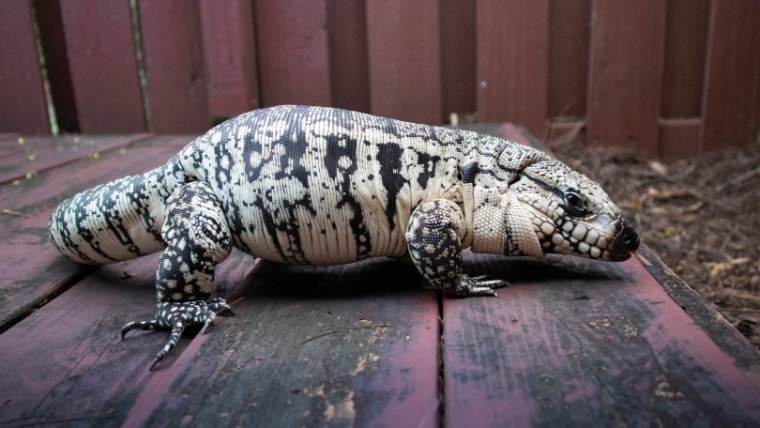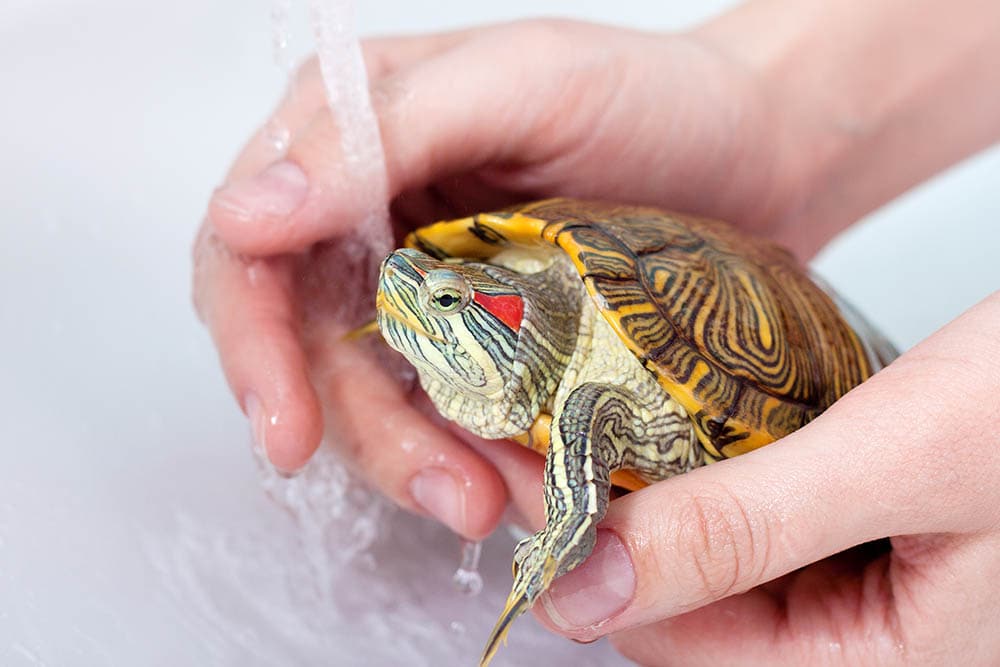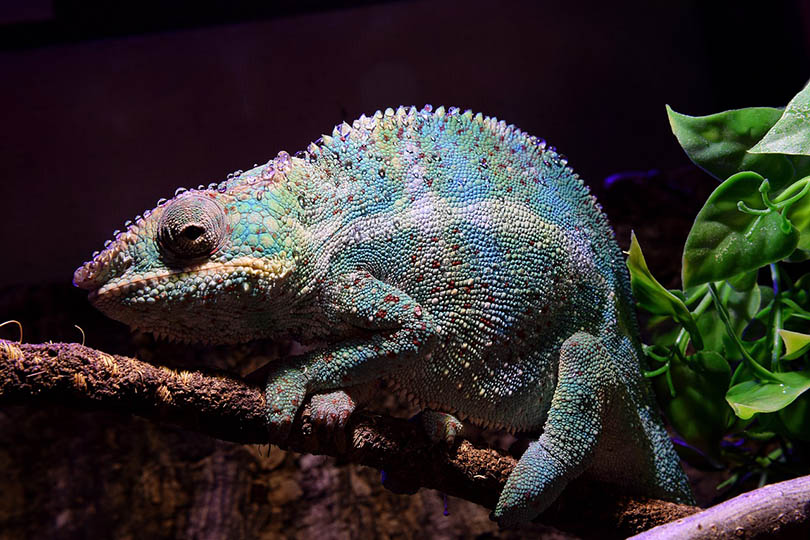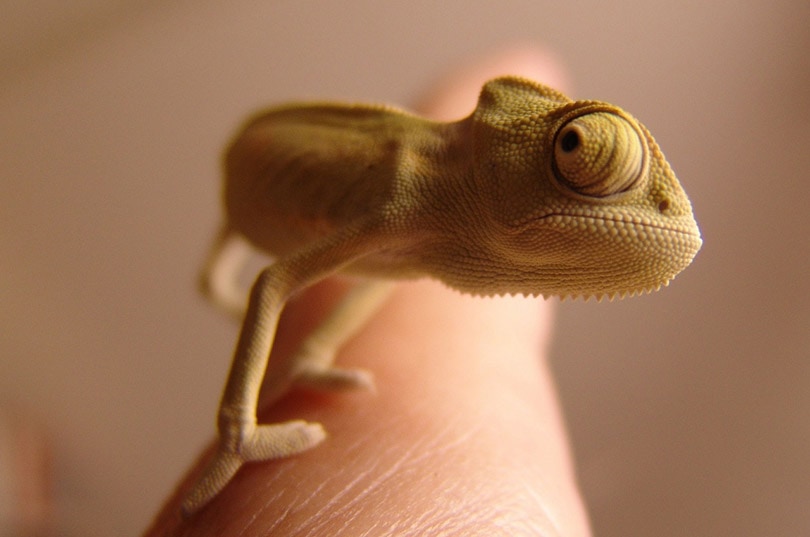
You might not think of a reptile as your first idea for a pet. However, 4.5 million households have one. The Blue Tegu is a fascinating animal, and it’s sure to satisfy your need for something exotic. While you can handle it, its care and adult size put it in the realm of the experienced pet owner. Indeed, housing will probably be one of your greatest challenges.
Quick Facts about Blue Tegu
| Species Name: | Salvator merianae |
| Common Name: | Blue Tegu |
| Care Level: | Easy to moderately easy |
| Lifespan: | 10-15 years |
| Adult Size: | Up to 3’ L |
| Diet: | Omnivore |
| Minimum Tank Size: | At least 6’ L |
| Temperature & Humidity
|
80℉-95℉
60%-80% |
Do Blue Tegus Make Good Pets?

Many reptiles might not make the best of pets because handling them is not recommended. That’s not the case with the Blue Tegu. It is quite docile compared to many similar species. However, the break-in period is lengthy if you didn’t get the animal when it was young. Some enthusiasts may insist that it enjoys handling. It will like your body’s warmth, in any case.
There are several challenges when owning a reptile of this size. The Blue Tegu is an omnivore, making it a challenge that the older and bigger it gets.
Appearance
The Blue Tegu is a stocky reptile that resembles a monitor. It has a blue-black mottled appearance, with a tapering snout that has a black spot on the end of it. It has long claws and finger-like appendages. The tail accounts for about one-third of its length.
How to Take Care of Blue Tegu
Habitat, Tank Conditions & Setup
This animal lives in the shrublands and forests of central South America. It is a generalist that will get a variety of foodstuffs in the wild. It is considered a species of least concern by the International Union for Conservation of Nature and Natural Resources.
Although the pet trade has impacted its native population, its primary threat are trapping for its skins. However, its population is stable.
Tank
A Blue Tegu will reach its adult size at about 5 years old. It will need a tank at least 6 feet long, preferably 8 feet, if possible. That will give it enough room to move. An aquarium will provide ideal living quarters for maintaining the right temperature and humidity. It can also ensure that your Tegu stays in its cage since it is something of an escape artist.
Daily cleaning of the walls is essential to ensure a healthy environment for your pet. You should also remove waste promptly. Change the substrate as necessary to keep odors in check.
Lighting
You should provide UV light for at least 12 hours a day. That can make a difference in where you place its cage. You can also set up an infrared ceramic heater to provide the necessary warmth without the light during the nighttime hours.
Heating (Temperature & Humidity)
The Blue Tegu prefers it on the warm side to replicate its native environment. Lighting and heaters will suffice. We recommend putting a thermometer in the cage to monitor the temperature. It shouldn’t get below 75℉. Daily misting is an excellent way to ensure that it’s humid enough inside of the aquarium. You should also add a sturdy water bottle that you should refill daily.
Substrate
You can use sphagnum moss or coconut fiber as a substrate, making sure it’s at least a 3-inch layer. Dampening it will boost the humidity levels inside of the tank. You should also provide hiding places, rocks, and pieces of bark so it can climb. In the wild, the Blue Tegu often spends most of its time in the canopy.
| Tank Recommendations | |
| Tank Type | 40-gallon glass vivarium |
| Lighting | UV light |
| Heating | Heating pad/tape on the bottom of the enclosure |
| Best Substrate | Coconut fiber
|
Feeding Your Blue Tegu

| Diet Summary | |
| Fruits | 5% of the diet |
| Insects | 90% of the diet when young; 25% as an adult |
| Meat | 75% of the diet, with pinky mice, hard-boiled egg, raw meats |
| Supplements Required | Calcium powder on its food, supplemented with a multi-vitamin twice weekly
|
Keeping Your Blue Tegu Healthy
Providing a healthy environment is the single best thing that you can do to keep your Blue Tegu healthy. Maintaining the correct humidity range will likely be your greatest challenge. The other concern is a clean tank. That means prompt removal of any uneaten food and waste to prevent bacteria development.
Common Health Issues

A healthy animal is active and alert. Sometimes, you will notice a decrease in its activity before shedding, though. Appetite is also an indication of whether they are well or ill. Common issues are respiratory problems, typically caused by conditions that are too damp or cold. We suggest monitoring the environment in its cage.
GI issues are another concern, primarily if you offer too many vegetables, which your Blue Tegu may have difficulty digesting. Fruits are much easier on their system. Other red flags include:
Lifespan
The Blue Tegu is fairly long-lived, given the proper environment. Its lifespan is up to 15 years, with some animals living up to 20 years in the right conditions. Remember that this reptile normally lives in places where the climate is relatively stable. That’s what you need to provide for your pet to keep it healthy.
Breeding
We don’t recommend trying to breed your Blue Tegu, especially if you don’t have enough space for a breeder tank. Adults don’t get along well, making it difficult. Even zoos haven’t been that successful with it. Bear in mind that breeding it is also illegal in some states, such as Florida, where these reptiles pose an ecological threat to native wildlife.
Are Blue Tegus Friendly? Our Handling Advice
The key is frequent handling to get your pet used to being around you. Do not attempt to grab your Blue Tegu by the tail, or else it may drop it to get away from you. You should move slowly around your pet, avoiding sudden movements, which can startle it. This reptile is intelligent and will likely soon make the association between you and food.
Shedding & Brumation: What to Expect
All lizards shed. Maintaining the humidity in the recommended range is the best thing that you can do to make sure it can get through this time with the least amount of stress. We suggest providing a large water bowl that your Blue Tegu can get into to moisten its skin in preparation for shedding. Daily misting is also essential. It may not be as active during this time.
How Much Do Blue Tegu Cost?
Blue Tegus are popular pets among reptile enthusiasts because of their docile nature and relatively easy care. You may find that it’s difficult to find one. You’ll likely pay upward of $600 for a young, healthy specimen.
Care Guide Summary
Conclusion
The Blue Tegu is a striking animal that would make an excellent pet as long as you can provide a suitable environment for it. If you get a young animal, you should handle it to make having one even more enjoyable as they grow. With the proper care, you can have many years with your exotic pet.
See Also:
Featured Image Credit: Jortiz9758, Shutterstock







